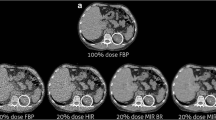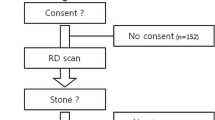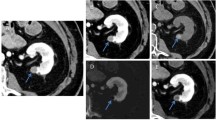Abstract
Purpose
The objective of this study is to establish the effect of third-generation integrated circuit (IC) CT detector on objective image quality in full- and half-dose non-contrast CT of the urinary tract.
Methods
51 consecutive patients with acute renal colic underwent non-contrast CT of the urinary tract using a 128-slice dual-source CT before (n = 24) and after (n = 27) the installation of third-generation IC detectors. Half-dose images were generated using projections from detector A using the dual-source RAW data. Objective image noise in the liver, spleen, right renal cortex, and right psoas muscle was compared between DC and IC cohorts for full-dose and half-dose images reconstructed with FBP and IR algorithms using 1 cm2 regions of interest. Presence and size of obstructing ureteric calculi were also compared for full-dose and half-dose reconstructions using DC and IC detectors.
Results
No statistical difference in age and lateral body size was found between patients in the IC and DC cohorts. Radiation dose, as measured by size-specific dose estimates, did not differ significantly either between the two cohorts (10.02 ± 4.54 mGy IC vs. 12.28 ± 7.03 mGy DC). At full dose, objective image noise was not significantly lower in the IC cohort as compared to the DC cohort for the liver, spleen, and right psoas muscle. At half dose, objective image noise was lower in the IC cohort as compared to DC cohort at the liver (21.32 IC vs. 24.99 DC, 14.7% decrease, p < 0.001), spleen (19.33 IC vs. 20.83 DC, 7.20% decrease, p = 0.02), and right renal cortex (20.28 IC vs. 22.98 DC, 11.7% decrease, p = 0.005). Mean obstructing ureteric calculi size was not significantly different when comparison was made between full-dose and half-dose images, regardless of detector type (p > 0.05 for all comparisons).
Conclusions
Third-generation IC detectors result in lower objective image noise at full- and half-radiation dose levels as compared with traditional DC detectors. The magnitude of noise reduction was greater at half-radiation dose indicating that the benefits of using novel IC detectors are greater in low and ultra-low-dose CT imaging.






Similar content being viewed by others
References
Smith RC, Rosenfield AT, Choe KA, et al. (1995) Acute flank pain: comparison of non-contrast-enhanced CT and intravenous urography. Radiology 194(3):789–794
Miller OF, Rineer SK, Reichard SR, et al. (1998) Prospective comparison of unenhanced spiral computed tomography and intravenous urogram in the evaluation of acute flank pain. Urology 52(6):982–987
Teichman JMH (2004) Clinical practice. Acute renal colic from ureteral calculus. N Engl J Med 350(7):684–693
Segura JW, Preminger GM, Assimos DG, et al. (1997) Ureteral stones clinical guidelines panel summary report on the management of ureteral calculi. The American Urological Association. J Urol 158(5):1915–1921
Coll DM, Varanelli MJ, Smith RC (2002) Relationship of spontaneous passage of ureteral calculi to stone size and location as revealed by unenhanced helical CT. AJR Am J Roentgenol 178(1):101–103
Sierakowski R, Finlayson B, Landes RR, Finlayson CD, Sierakowski N (1978) The frequency of urolithiasis in hospital discharge diagnoses in the United States. Invest Urol 15(6):438–441
Curhan GC, Willett WC, Rimm EB, Stampfer MJ (1997) Family history and risk of kidney stones. J Am Soc Nephrol JASN 8(10):1568–1573
Romero V, Akpinar H, Assimos DG (2010) Kidney stones: a global picture of prevalence, incidence, and associated risk factors. Rev Urol 12(2–3):e86–e96
Liu W, Esler SJ, Kenny BJ, et al. (2000) Low-dose nonenhanced helical CT of renal colic: assessment of ureteric stone detection and measurement of effective dose equivalent. Radiology 215(1):51–54
Heneghan JP, McGuire KA, Leder RA, et al. (2003) Helical CT for nephrolithiasis and ureterolithiasis: comparison of conventional and reduced radiation-dose techniques. Radiology 229(2):575–580
Mulkens TH, Daineffe S, De Wijngaert R, et al. (2007) Urinary stone disease: comparison of standard-dose and low-dose with 4D MDCT tube current modulation. AJR Am J Roentgenol 188(2):553–562
Tartari S, Rizzati R, Righi R, et al. (2010) Low-dose unenhanced CT protocols according to individual body size for evaluating suspected renal colic: cumulative radiation exposures. Radiol Med (Torino) 115(1):105–114
Meagher T, Sukumar VP, Collingwood J, et al. (2001) Low dose computed tomography in suspected acute renal colic. Clin Radiol 56(11):873–876
Hamm M, Knopfle E, Wartenberg S, et al. (2002) Low dose unenhanced helical computerized tomography for the evaluation of acute flank pain. J Urol 167(4):1687–1691
Tack D, Sourtzis S, Delpierre I, de Maertelaer V, Gevenois PA (2003) Low-dose unenhanced multidetector CT of patients with suspected renal colic. AJR Am J Roentgenol 180(2):305–311
Katz DS, Venkataramanan N, Napel S, Sommer FG (2003) Can low-dose unenhanced multidetector CT be used for routine evaluation of suspected renal colic? AJR Am J Roentgenol 180(2):313–315
Kluner C, Hein PA, Gralla O, et al. (2006) Does ultra-low-dose CT with a radiation dose equivalent to that of KUB suffice to detect renal and ureteral calculi? J Comput Assist Tomogr 30(1):44–50
Kim BS, Hwang IK, Choi YW, et al. (2005) Low-dose and standard-dose unenhanced helical computed tomography for the assessment of acute renal colic: prospective comparative study. Acta Radiol 46(7):756–763
Sagara Y, Hara AK, Pavlicek W, Silva AC, Paden RG, Wu Q. 2012 Abdominal CT: comparison of low-dose CT With adaptive statistical IR and routine-dose CT With FBP in 53 Patients [Internet]. [cited 2014 Mar 25]. from http://www.ajronline.org/doi/full/10.2214/AJR.09.2989.
Winklehner A, Blume I, Winklhofer S, et al. (2013) Iterative reconstructions vs. filtered back-projection for urinary stone detection in low-dose CT. Acad Radiol 20(11):1429–1435
Kulkarni NM, Uppot RN, Eisner BH, Sahani DV (2012) Radiation dose reduction at multidetector CT with adaptive statistical IR for evaluation of urolithiasis: how low can we go? Radiology 265(1):158–166
Ulzheimer S, Freund J (2012) The Stellar Detector. CA: White Pap Siemens Healthc
Fletcher JG, Grant KLR, Fidler JL, et al. (2012) Validation of dual-source single-tube reconstruction as a method to obtain half-dose images to evaluate radiation dose and noise reduction: phantom and human assessment using CT colonography and sinogram-affirmed IR (SAFIRE). J Comput Assist Tomogr 36(5):560–569
Spielmann AL, Heneghan JP, Lee LJ, Yoshizumi T, Nelson RC (2002) Decreasing the radiation dose for renal stone CT: a feasibility study of single- and multidetector CT. AJR Am J Roentgenol 178(5):1058–1062
Tublin ME, Murphy ME, Delong DM, Tessler FN, Kliewer MA (2002) Conspicuity of renal calculi at unenhanced CT: effects of calculus composition and size and CT technique. Radiology 225(1):91–96
Kalra MK, Maher MM, D’Souza RV, et al. (2005) Detection of urinary tract stones at low-radiation-dose CT with z-axis automatic tube current modulation: phantom and clinical studies. Radiology 235(2):523–529
Ciaschini MW, Remer EM, Baker ME, Lieber M, Herts BR (2009) Urinary calculi: radiation dose reduction of 50% and 75% at CT–effect on sensitivity. Radiology 251(1):105–111
Karmazyn B, Frush DP, Applegate KE, et al. (2009) CT with a computer-simulated dose reduction technique for detection of pediatric nephroureterolithiasis: comparison of standard and reduced radiation doses. AJR Am J Roentgenol 192(1):143–149
Jin DH, Lamberton GR, Broome DR, et al. (2010) Effect of reduced radiation CT protocols on the detection of renal calculi. Radiology 255(1):100–107
Sohn W, Clayman RV, Lee JY, Cohen A, Mucksavage P (2013) Low-dose and standard computed tomography scans yield equivalent stone measurements. Urology 81(2):231–234
Lidén M, Andersson T, Broxvall M, Thunberg P, Geijer H (2012) Urinary stone size estimation: a new segmentation algorithm-based CT method. Eur Radiol 22(4):731–737
Bultitude M, Rees J (2012) Management of renal colic. BMJ 345:e5499
Furlan A, Federle MP, Yealy DM, Averch TD, Pealer K (2008) Nonobstructing renal stones on unenhanced CT: a real cause for renal colic? AJR Am J Roentgenol 190(2):W125–W127
Morsbach F, Bickelhaupt S, Rätzer S, Schmidt B, Alkadhi H (2014) Integrated Circuit Detector Technology in Abdominal CT: Added Value in Obese Patients. Am J Roentgenol 202(2):368–374
Conflict of interest
None of the authors above have anything to disclose.
Author information
Authors and Affiliations
Corresponding author
Rights and permissions
About this article
Cite this article
Wang, J., Kang, T., Arepalli, C. et al. Half-dose non-contrast CT in the investigation of urolithiasis: image quality improvement with third-generation integrated circuit CT detectors. Abdom Imaging 40, 1255–1262 (2015). https://doi.org/10.1007/s00261-014-0264-0
Published:
Issue Date:
DOI: https://doi.org/10.1007/s00261-014-0264-0




